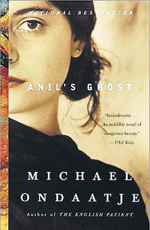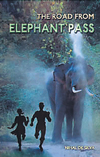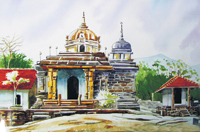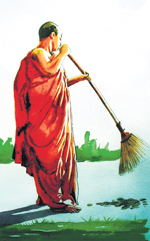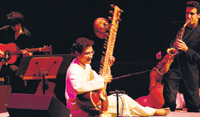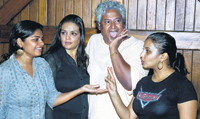|
|
||||||||||||||||||||
|
Our writers and the tyranny of authenticity
When the wave of creative Sri Lankan writing in English began forming as a concerted movement a quarter of a century ago it had a furtive aspect about it, as if writing in English in this country was something to feel guilty about. Indeed, there were some who confessed that they would have preferred to write in the venacular if only they had the ability.
Now that the legitimacy, if not the primacy, of English in our modern context has been recognized, that apologetic air has long since been shed. However, while the wave is now swelling to its crest, the celebration of its breaking in a profusion of writing with international acceptance is threatened by a stricture of another sort. Imposed this time by the very people entrusted with encouraging creative English writing in Sri Lanka, it is the insistence that such writing be authentically Sri Lankan. The qualification “Sri Lankan” as applied to creative writing in English refers simply to the nationality and also, perhaps, the residential status of the writer. It has no other significance. However, it has been expanded to cover the very nature and scope of the writing. This is now required to exhibit a distinctively Sri Lanka character in regard to subject matter, theme, characterization, plot and language itself. In other words, the requirement of creativity in respect of these elements has given way to this requirement of authenticity. It is a shift that has subtly been taking place in recent years until now. With the rearing up of the wave, authenticity seems to have taken over from creativity as the sine qua non of Sri Lankan writing in English.
There is nothing wrong with authenticity in itself. In fact, it is essential to creativity. And it is the job of the literary critic or arbiter to distinguish between authentic creativity and creativity that is forced or faked. This sort of authenticity ensures that the writing is representative of real life and is based on genuinely felt experience. And that the creative imagination has been at work in the employment of language, style, setting etc. in such a way that the writing affects not just the mind but the heart, the inner person, of the reader. But this need for genuine authenticity is lost sight of, in the craze for a Sri Lankan authenticity. This obsession is tantamount to insisting that creative writing bear a Sri Lankan brand or trademark. Such branding may be right and proper for a product or service, such as Ceylon Tea or SriLankan Airlines. But it is not fitting for art, since art should transcend national boundaries. Its appeal is in its universality, not in its origin which is of secondary significance. There is, of course, the lesser type of art represented, say, by handicrafts. These do need the stamp or brand of Sri Lankan authenticity and to conform to certain predetermined national characteristics to be marketable. Not so creative writing, unless we want to relegate it to the level of a handicraft. In that event, the critic or arbiter would become a sort of literary tourist guide catering to an audience of souvenir hunters of typically Sri Lankan literature. Of course, it is much easier to assess writing on the basis of such authenticity than on the basis of creativity. The arbiter has only to define for himself what constitutes Sri Lankan authenticity as regards themes, subject matter, characterization, style and language, and assess accordingly. But such definition and assessment are purely subjective, based as they are on the arbiter’s personal interest and experience. It is also an encroachment on the writer’s right to determine these elements of his art on the basis of his own interest and experience. Writers confronted with the critical demand for Sri Lankan authenticity have the right to demand of the arbiter, in the words of one of Henry James’ characters, “Why should the range of your vision be the limit of my action?” Too often, however, under the pressure to be recognized, writers might yield and adapt their creative choices and effects to meet the demands of Sri Lankan authenticity. They would thus, in effect, be comparable to competitors in an all-island essay competition, having to pick their authentically Sri Lankan subjects from a list prepared by the organizers. Far more difficult is it for the arbiter to assess genuine creativity, but this is his only legitimate function. Far more difficult than to determine whether the milieu of a novel is authentically Sri Lankan is it to determine whether the novelist has been able “to give to airy nothing a local habitation and a name” so that his theme is imaginatively realized. As Romesh Gunesekera has said in a recent interview, “A novel has to create a world and cannot simply rely on the real place to provide sustenance.” Far more difficult than to determine whether a poet’s language is authentically Sri Lankan is it to determine whether his language has the evocative power to “transmute his personal and private agonies into something rich and strange, something universal and impersonal.” But if only the critic or arbiter would make this effort (assuming he is capable of it), he would surely delight to discover in the process a kind of Sri Lankan authenticity that far transcends his preconceived notion thereof, an authenticity that is the result rather than the precondition of true creativity. Not “the mere trappings and the suits” of Sri Lankan authenticity but “that within which passeth show”. Such genuinely Sri Lankan authenticity does not merely strive to reflect the Sri Lankan experience. For instance, Michael Ondaatje’s highly researched “Anil’s Ghost” redefines the Sri Lankan experience as Nihal de Silva’s “Road from Elephant Pass” does. Indeed, if any Sri Lankan novelist in English has succeeded, in the words of James Joyce, in “forging the uncreated conscience" not of his “race’ but of his Sri Lankan countrymen, it is Nihal de Silva. It is significant that in terms of the superficial type of Sri Lankan authenticity we have been talking about, “The Road from Elephant Pass” has little to recommend it. In fact, the continued relevance of its so-called ethnic theme was questioned by some at the time of its achieving the limelight. The language and the characterization are not typically Sri Lankan, both protagonist and antagonist possessing an English articulateness as well as a level of general and ornithological knowledge unlikely to be found in their real-life counterparts. Yet the reader is more than ready to engage in “the willing suspension of disbelief” and to accept these seeming inconsistencies as part and parcel of what Aristotle called the plausible impossibilities of Greek tragedy. For his is actually what the creative imagination has wrought in “Elephant Pass.,” a truly tragic novel, a genuinely Sri Lankan tragedy. It is time that writers, readers and critics united to throw off the present tyranny of authenticity so that Sri Lankan writing in English may achieve its full creative potential as its Indian counterpart has already done.
Brush with history and serenity
“When I was a child, I loved to see colours being mixed in water. Later in life, I used these water-mixed colours to do an illustration on black paper.
“This is when I realised the magic of painting in watercolours. Oil colours are easy to experiment with- once a mistake is detected; it’s easy to erase it. But that’s not the case with water colours,” says Ranjitha Kamalanth. Born in Mirigama, and educated at Giriulla Wickramashila National School, Ranjitha, 28, chose arts as a subject for his O’ Ls and A’Ls. Wanting to experiment with a different form of art and to find out where his career goals lay he ventured into sculpture. “I wanted to get involved in a different aspect of the arts and joined the Academy of Sculpture, in Pasyala,” Ranjitha said.
While waiting to enter University, he ventured into painting once again and realised that this was where both his heart and career lay. Most of Ranjitha’s paintings and sculptures highlight historical, archaeological and religious sites. “I also like painting Buddhist monks as it gives me a feeling of serenity. People who buy my paintings also tell me they feel that same sense of serenity. Ranjitha’s third exhibition “Shikshapada” will be held from August 3 to August 6 at the Lionel Wednt Art Gallery.
"Pradeepanjalee" rocks Los Angeles Pradeep Ratnayake's blending of eastern rhythms with western jazz was so mesmerizing, the 1,100 strong audience at the famous Walt Disney Concert Hall gave him a standing ovation when Pradeepanjalee had its global launch in Los Angeles on July 22.
Pandit Ravi Shankar had performed at the same venue in April this year. This time, it was the turn of Pradeep and his troupe- Lakshman de Saram, Wijeratne Ranatunga, Karunaratne Bandara and Alston Joachim fused with jazz giants like Eric Marienthal at the sax, Freddie Ravel at the piano and Hussein Jiffry at the bass guitar to produce a most memorable evening. The concert was presented by the Sri Lanka Foundation.
... and the wedding of the year is
Indu Dharmasena’s comedy ‘Oh Colombo’ which had audiences in stitches last year will pick up from where it left off with ‘Oh Colombo 2 - Weddings!’ hitting the stage this week.
The play begins with Suresh’s mother-in-law, Mala, announcing that she has hired a wedding coordinator, Chamathkara, a Sri Lankan residing in the US, who has been specially flown down to plan and coordinate her daughter’s wedding. Mala is a typical Colombo mother who wants her only daughter’s wedding to be remembered as Colombo’s best ever. Suresh and his bride, Natasha, are not all that keen on the idea. All they want is a simple ceremony with close family and friends. In the meantime, Harold, Suresh’s uncle is also soon to be married to Rathna and announces that they have hired the classiest wedding planner in town, Menaka Suralova. The moment the two coordinators meet, the fun begins, with one trying to outdo the other. The cast includes Koluu (whose costumes are done by Lou Ching Wong), Angela Seneviratne, Indu Dharmasena, Abbasali Rozais, Sanjana Selvarajah, Michelle Herft, Sanawada Abeysirigunawardena, George Cooke, Danu, Gehan Cooray, Ishkey Irshad and Dilli Wijawardana. ‘Oh Colombo 2 - Weddings!’ will go on the boards at the Lionel Wendt on August 4, 5 and 6 at 7.15 pm.
Celebrating Mozart The Colombo Philharmonic Choir conducted by Manilal Weerakoon will present a programme of sacred music featuring the works of Mozart and other composers on Sunday, August 6, at the Ladies College Chapel. The Choir considered it fitting to give thanks to God for Mozart’s genius, by focusing attention on excerpts from two of his major works: the Requiem in D minor and the great Mass in C minor. The programme will include the jubilant “Regina Coeli” and his well loved Lied, “Abendempfindung Laura” that will be sung by baritone Dhilan Gnanadurai. The other soloist at this concert will be Minoli Goonewardene (soprano). The choir has widened the scope of this thanksgiving by including the works of two other acknowledged masters of sacred music, - Felix Mendelssohn and Anton Bruckner. The programme also includes ‘The Lord’s Prayer’ composed by the young Sri Lankan tenor and musician, Asitha Tennekoon. The accompanists are Soundarie David and Neranjan de Silva.
Little play-makers
‘The Land of Make Believe’, a colourful medley of five little plays performed by a group of 6-10 year olds is an expression of the creativity and imagination of young children. Directed by Neluka Silva, the performance is a culmination of a series of workshops called ‘Kids @ Play’ which have been held by her at the British Council over several weeks. At these workshops children learn various aspects of theatre in a manner that they enjoy and that lets them explore their own ideas. Concentration exercises, music, mimes, trust-building exercises and an introduction to elements of the stage and theatre are among the things they discover at the workshops. These plays are special, says Neluka, because they are being performed without the aid of a written script. This allows the children to unleash their imagination and explore their creativity to the maximum. Gehan Cooray, who has helped in putting the production together, says that while this method allows for spontaneous dialogue, the story line and characters of the play are clear cut and therefore the basic structure doesn’t really change although it allows for more flexibility. Three of the plays are from stories that the children have written themselves. Neluka, a Senior Lecturer at the Department of English at the University of Colombo, presently on sabbatical leave, has been actively involved in Sri Lankan English theatre for many years. ‘The Land of Make Believe’ will go on stage on August 3 at 7 p.m. at the British Council Hall.
From masterclass in Austria to Colombo recital London-based duo, Caroline Jaya-Ratnam, pianoforte, and Dhilan Gnanadurai, baritone, whose performance delighted Colombo audience a year ago, will give another recital of lieder, songs and operatic arias, and of piano music on Tuesday, August 8 at the Russian Centre.
The main work in their programme will be Brahms Opus 57, a collection of eight lieder and songs linked by underlying themes of love, heartache and romance. They studied this work in a week long residential masterclass for singer and piano duos a month ago under Roger Vignoles at Linz in Austria. This will be their first public performance of the Brahms since then.
Admission programmes are available at the Russian Centre and the recital starts at 7.30 pm. It is presented by Camerata Musica. |
||||||||||||||||||||
Copyright © 2006 Wijeya Newspapers
Ltd. All rights reserved. |
